A) economy will move up along curve B and output will temporarily increase.
B) long-run aggregate supply curve C will shift upward.
C) short-run aggregate supply curve B will automatically shift to the right.
D) economy's output first will decline, then increase, and finally return to Q1.
Correct Answer

verified
Correct Answer
verified
True/False
A decrease in per unit production costs will shift the aggregate supply curve leftward.
Correct Answer

verified
Correct Answer
verified
Multiple Choice
Refer to the diagram given below. 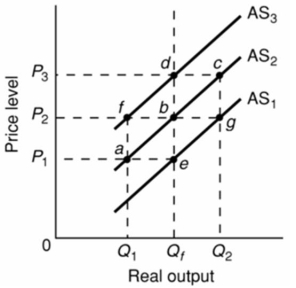 Assume that the nominal wages of workers in an economy are initially set on the basis of the price level P2 and that the economy is initially operating at the full-employment level of output Qf.In the long run, an increase in the price level from P2 to P3 will:
Assume that the nominal wages of workers in an economy are initially set on the basis of the price level P2 and that the economy is initially operating at the full-employment level of output Qf.In the long run, an increase in the price level from P2 to P3 will:
A) increase the real output from Qf to Q2.
B) shift the aggregate supply curve from AS2 to AS1.
C) decrease the real output from Q2 to Q1.
D) not change the level of real output.
Correct Answer

verified
Correct Answer
verified
True/False
Depreciation of the dollar relative to foreign currencies will tend to increase net exports and aggregate demand.
Correct Answer

verified
Correct Answer
verified
Multiple Choice
If personal taxes were decreased and input productivity increased simultaneously, the equilibrium:
A) output would rise.
B) output would fall.
C) price level would necessarily fall.
D) price level would necessarily rise.
Correct Answer

verified
Correct Answer
verified
Multiple Choice
Which of the diagrams below best portrays the effects of an increase in consumer spending? 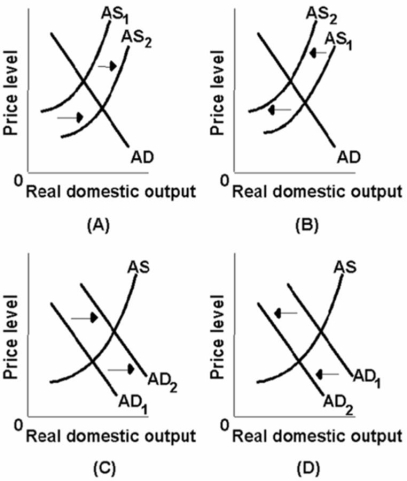
A) A
B) B
C) C
D) D
Correct Answer

verified
Correct Answer
verified
Multiple Choice
 Which of the above diagrams best portrays the effects of a dramatic increase in energy prices?
Which of the above diagrams best portrays the effects of a dramatic increase in energy prices?
A) A
B) B
C) C
D) D
Correct Answer

verified
Correct Answer
verified
Multiple Choice
The following table shows the aggregate demand and aggregate supply schedule for a hypothetical economy.  Refer to the above table.The equilibrium price level and quantity of real domestic output will be:
Refer to the above table.The equilibrium price level and quantity of real domestic output will be:
A) 150 and $1000.
B) 150 and $1500.
C) 200 and $2000.
D) 250 and $2500.
Correct Answer

verified
Correct Answer
verified
Multiple Choice
Other things being equal, if the national incomes of our major international lending partners were to rise, our:
A) aggregate demand curve would shift to the right.
B) aggregate supply curve would shift to the left.
C) aggregate supply curve would shift to the right.
D) aggregate demand curve would shift to the left.
Correct Answer

verified
Correct Answer
verified
Multiple Choice
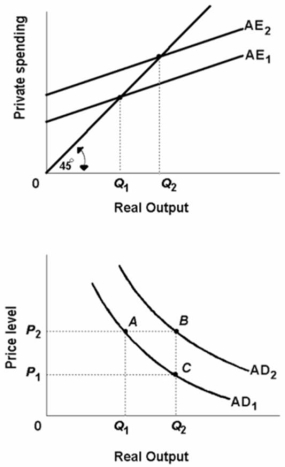 Refer to the above diagrams.A decline in aggregate expenditures from AE2 to AE1resulting from the wealth, interest rate, and foreign trade effects would be depicted as:
Refer to the above diagrams.A decline in aggregate expenditures from AE2 to AE1resulting from the wealth, interest rate, and foreign trade effects would be depicted as:
A) a movement from A to B along aggregate demand curve AD1.
B) a movement from C to A along aggregate demand curve AD1.
C) a shift of aggregate demand from AD1 to AD2.
D) a shift of aggregate demand from AD2 to AD1.
Correct Answer

verified
Correct Answer
verified
Multiple Choice
The economy experiences an increase in the price level and a decrease in real domestic output.Which is a likely explanation?
A) productivity has increased
B) input prices have increased
C) excess capacity has decreased
D) government regulations have been reduced
Correct Answer

verified
Correct Answer
verified
Multiple Choice
Productivity is calculated by:
A) dividing total output by total input.
B) dividing total input by total output.
C) multiplying total output by total input.
D) adding total input to total output.
Correct Answer

verified
Correct Answer
verified
Multiple Choice
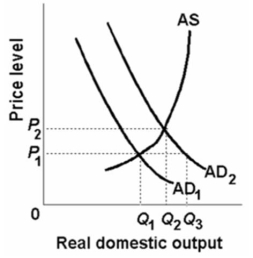 Refer to the above diagram.If equilibrium real output is Q2, then:
Refer to the above diagram.If equilibrium real output is Q2, then:
A) aggregate demand is AD1.
B) the equilibrium price level is P1.
C) producers will supply output level Q1.
D) the equilibrium price level is P2.
Correct Answer

verified
Correct Answer
verified
Multiple Choice
The interest rate effect indicates that a(n) :
A) decrease in the price level will increase the demand for money, increase interest rates, and decrease consumption and investment spending.
B) decrease in the price level will decrease the demand for money, decrease interest rates, and increase consumption and investment spending.
C) increase in the price level will increase the demand for money, reduce interest rates, and decrease consumption and investment spending.
D) increase in the supply of money will increase interest rates and decrease interest-sensitive consumption and investment spending.
Correct Answer

verified
Correct Answer
verified
Multiple Choice
Refer to the diagram given below. 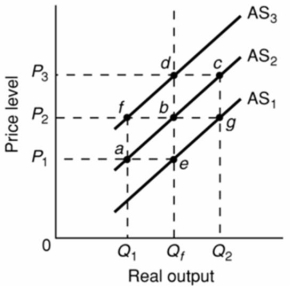 Assume that the nominal wages of workers in an economy are initially set on the basis of the price level P2 and that the economy initially is operating at the full-employment level of output Qf.In the diagram, the long-run aggregate supply curve:
Assume that the nominal wages of workers in an economy are initially set on the basis of the price level P2 and that the economy initially is operating at the full-employment level of output Qf.In the diagram, the long-run aggregate supply curve:
A) is represented by AS2.
B) is a vertical line extending from Qf upward through the points e, b, and d.
C) may be either AS1, AS2, or AS3 depending on whether the price level is P1, P2, or P3.
D) is a horizontal line extending from P2 rightward through points f, b, and g.
Correct Answer

verified
Correct Answer
verified
Multiple Choice
A decrease in the price level in the aggregate expenditures model would:
A) decrease aggregate expenditures and real GDP.
B) increase aggregate expenditures and real GDP.
C) decrease aggregate expenditures and increase real GDP.
D) increase aggregate expenditures and decrease real GDP.
Correct Answer

verified
Correct Answer
verified
Multiple Choice
An increase in government spending can be expected to shift the:
A) aggregate expenditures curve downward and the aggregate demand curve leftward.
B) aggregate expenditures curve upward and the aggregate demand curve leftward.
C) aggregate expenditures curve downward and the aggregate demand curve rightward.
D) aggregate expenditures curve upward and the aggregate demand curve rightward.
Correct Answer

verified
Correct Answer
verified
Multiple Choice
The interest-rate effect causes the aggregate demand curve for an economy to:
A) slope downward.
B) slope upward.
C) become flatter.
D) becomes teeper.
Correct Answer

verified
Correct Answer
verified
Multiple Choice
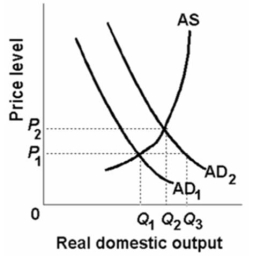 Refer to the above diagram.At the equilibrium price and quantity:
Refer to the above diagram.At the equilibrium price and quantity:
A) aggregate demand exceeds aggregate supply.
B) the amount of real output demanded and supplied are equal.
C) aggregate demand equals aggregate supply.
D) aggregate supply exceeds aggregate demand.
Correct Answer

verified
Correct Answer
verified
Multiple Choice
Which of the following would not shift the aggregate supply curve?
A) an increase in labour productivity
B) a decline in the price of imported oil
C) a decline in business taxes
D) an increase in the price level
Correct Answer

verified
Correct Answer
verified
Showing 61 - 80 of 203
Related Exams